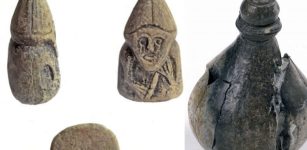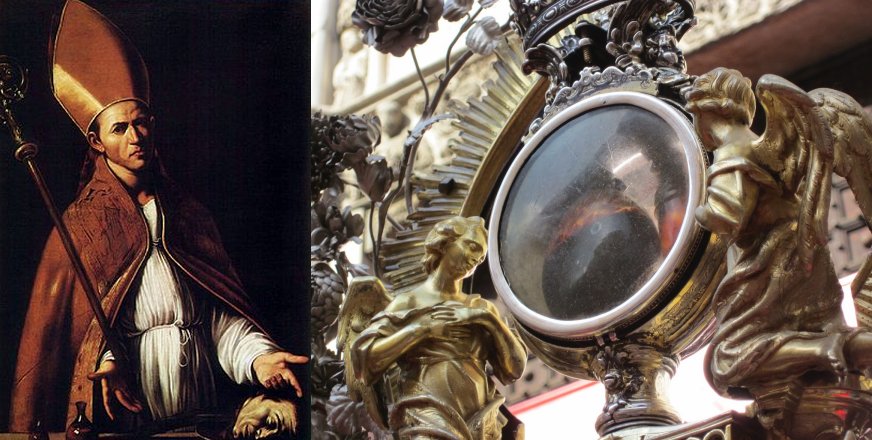Blood Of St. Januarius – One Of The Most Remarkable Christian Relics
Ellen Lloyd - Ancient Pages.com - One of the most remarkable Christian relics is a sealed glass ampoule that contains the blood of St. Januarius.
It’s a sacred Christian object that often causes a lot of attention. For some unknown reason, the black mass sometimes fails to liquefy and this is regarded as a bad omen. It is said that when the blood fails to liquefy, something tragic will happen to the city of Naples that year.
Who Was St. Januarius?
St. Januarius is venerated figure among the Neopolitans, and the annual celebration and viewing of the miracle is a highly significant and prophetic event.
On June 13, 313 AD, Edict of Milan was signed by Roman Emperor Constantine and the persecution of Christians ended. St. Januarius was not fortunate enough to experience that day. He was killed about 305 B.C., during the Diocletianic Persecution that was the last and most severe persecution of Christians in the Roman Empire.
Bon in Italy during the 3rd century, St. Januarius was declared a martyr and saint of the Roman Catholic and the Eastern Orthodox Churches. We possess very little information about his life, but we know he was bishop of Benevento during the Emperor Diocletion persecution.
Martyrdom of Saint Januarius by Girolamo Pesce - Bishop's Library, Vác, Hungary.
According to legend, Januarius became a priest when he was only 15 years. These were dangerous times for Christians. Living in a pagan society many believers feared for their lives. When Januarius was 20 he became bishop and during the 1 1⁄2-year-long persecution of Christians by Emperor Diocletian, bishop Januarius and his Christian followers managed to avoid being caught. ‘
However, while visiting two deacons and two laymen in prison, bishop Januarius was arrested and sentenced to death. There are two versions of how he died. According to some stories, bishop Januarius and his colleagues were condemned to be thrown to wild bears in the Flavian Amphitheater at Pozzuoli.
See also:
Biblical Mystery Of Urim And Thummim: God’s Puzzling Communication Devices
Mesha Stele: One Of The Most Valuable Biblical Artifacts
Lost Q Source Remains An Unsolved Biblical Mystery
Due to fear of public disturbances, the sentenced was changed and they were instead beheaded at the Solfatara crater near Pozzuoli. One legend tells, these Christian men were thrown to the wild beasts, but when the animals did not attack them, they were beheaded instead.
Today, the feast of St. Januarius is held on September 19 and he is patron of blood banks. Although the city of Naples has more than fifty official patron saints, its principal patron is Saint Januarius.
Mystery Of The Ampoule Containing The Blood Of St. Januarius
The most remarkable part of St. Januarius’ history concerns his blood. According to an ancient legend, a woman by the name Eusebia saved his blood shortly after he died. His blood today is kept in a sealed glass ampoule in Naples Cathedral and traditionally liquefies three times a year: on September 19, December 16 and the Saturday before the first Sunday of May.
Thousands of people gather to witness the miracle because it is believed that the failure of the saint's blood to liquefy is associated with disastrous events.
Many people of Naples are concerned and remember the blood remaining solid a be a premonition of evil.
The same things happened in 1980, when an earthquake hit South Italy; 1973, when Naples endured an outbreak of cholera; 1939, when World War II began; 1940, when Italy joined the War and 1943, when Italy was occupied by the Nazis.
Blood of St. Januarius is kept in a sealed glass ampoule.
However, the blood is also said to spontaneously liquefy at certain other times, such as papal visits. Putting faith aside for a brief moment, we have right to wonder whether there is a scientific explanation as to why liquefaction sometimes takes place almost immediately and sometimes not at all.
This is the greatest problem because while the Catholic Church has always supported the celebrations, it has never formulated an official statement on the phenomenon and maintains a neutral stance about scientific investigations.
The blood of St Januarius is a sacred Christian relic that is kept in a vault and access and scientific studies are denied because of fear that examination of this sacred blood may cause irreparable damage.
On feast days, all relics, including St. Januarius’ blood are taken in procession from the cathedral to the Monastery of Santa Chiara, where the archbishop holds the reliquary up and tilts it to show that the contents are solid, and places it on the high altar next to the saint's other relics.
Even though a few early scientific studies were conducted, the results did not provide satisfactory explanation to the blood’s unusual behavior.
In more recent times, scientists have suggested that blood vial contains a thixotropic gel that changes in viscosity when someone moves or stirs it. Another theory is that the vials do not contain blood at all but hydrated iron oxide which resembles blood.
Currently, the blood of St. Januarius remains a mystery and scientists have yet to find a cause for the blood liquefying, but most researchers have ruled out the possibility the relic is a fraud.
Written by Ellen Lloyd – AncientPages.com
Copyright © AncientPages.com & Ellen Lloyd All rights reserved. This material may not be published, broadcast, rewritten or redistributed in whole or part without the express written permission of AncientPages.com and Ellen Lloyd
About the author:
Ellen Lloyd – is the owner of AncientPages.com and an author who has spent decades researching ancient mysteries, myths, legends and sacred texts, but she is also very interested in astronomy, astrobiology and science in general
More From Ancient Pages
-
 Europe’s Earliest Culture Of Aurignacian People Made Amazing Images With Dots
Archaeology | Mar 5, 2017
Europe’s Earliest Culture Of Aurignacian People Made Amazing Images With Dots
Archaeology | Mar 5, 2017 -
 Biblical Vineyard Of Naboth Existed And Has Been Found
Archaeology | Aug 3, 2017
Biblical Vineyard Of Naboth Existed And Has Been Found
Archaeology | Aug 3, 2017 -
 On This Day In History: ‘Sea King’ Ragnar Lodbrok Seizes Paris – On March 28, 845
Featured Stories | Mar 28, 2016
On This Day In History: ‘Sea King’ Ragnar Lodbrok Seizes Paris – On March 28, 845
Featured Stories | Mar 28, 2016 -
 Knights Templar’s Legendary Sword In Stone In Terminillo Mysteriously Disappeared – Where Is It Hidden?
Featured Stories | May 3, 2021
Knights Templar’s Legendary Sword In Stone In Terminillo Mysteriously Disappeared – Where Is It Hidden?
Featured Stories | May 3, 2021 -
 Ancient Manuscript In Museum Reveals Discovery Of Objects Unknown To Modern Science – Coptic Secrets And Guardians Of Treasures – Part 2
Ancient Mysteries | Apr 11, 2021
Ancient Manuscript In Museum Reveals Discovery Of Objects Unknown To Modern Science – Coptic Secrets And Guardians Of Treasures – Part 2
Ancient Mysteries | Apr 11, 2021 -
 Ancient Mystery Of Pharaohs And Gods With Two Left Or Two Right Hands – A Deeper Investigation
Featured Stories | Jan 30, 2025
Ancient Mystery Of Pharaohs And Gods With Two Left Or Two Right Hands – A Deeper Investigation
Featured Stories | Jan 30, 2025 -
 Can Discovered Algonquian Artifacts Solve Mystery Of The Lost Colony On Roanoke Island?
Archaeology | May 13, 2024
Can Discovered Algonquian Artifacts Solve Mystery Of The Lost Colony On Roanoke Island?
Archaeology | May 13, 2024 -
 Forgotten Notebook Reveals Da Vinci Understood Gravitiy Long Before Newton
Ancient Technology | Feb 22, 2023
Forgotten Notebook Reveals Da Vinci Understood Gravitiy Long Before Newton
Ancient Technology | Feb 22, 2023 -
 Why Should There Be An Iron Throne Inside The Cheops’ Pyramid?
Archaeology | Apr 16, 2018
Why Should There Be An Iron Throne Inside The Cheops’ Pyramid?
Archaeology | Apr 16, 2018 -
 Peculiar Artifact Discovered In Tomb Of The Warrior Queen Fu Hao
Artifacts | Oct 26, 2018
Peculiar Artifact Discovered In Tomb Of The Warrior Queen Fu Hao
Artifacts | Oct 26, 2018 -
 Valentine’s Day’s Connection With Love Was Probably Invented By Chaucer And Other 14th-Century Poets
Ancient Traditions And Customs | Feb 14, 2023
Valentine’s Day’s Connection With Love Was Probably Invented By Chaucer And Other 14th-Century Poets
Ancient Traditions And Customs | Feb 14, 2023 -
 Old Norse Settlers Traded Walrus Ivory With Kyiv – Spectacular Archaeological Finds Reveal
Archaeology | Jun 16, 2022
Old Norse Settlers Traded Walrus Ivory With Kyiv – Spectacular Archaeological Finds Reveal
Archaeology | Jun 16, 2022 -
 Sun Chariot – Powerful Symbol Of Bronze Age Cosmology
Ancient Symbols | Feb 28, 2018
Sun Chariot – Powerful Symbol Of Bronze Age Cosmology
Ancient Symbols | Feb 28, 2018 -
 Gruesome Discovery Of Headless Bodies In Vráble, Slovakia – Remains Of Stone Age Cult Victims Unearthed
Archaeology | Sep 24, 2022
Gruesome Discovery Of Headless Bodies In Vráble, Slovakia – Remains Of Stone Age Cult Victims Unearthed
Archaeology | Sep 24, 2022 -
 On This Day In History: The Battle Of The Nile Concludes In A British Victory – On August 2, 1798
News | Aug 2, 2016
On This Day In History: The Battle Of The Nile Concludes In A British Victory – On August 2, 1798
News | Aug 2, 2016 -
 Glory And Fall Of Babylon Dedicated To The Cult Of Marduk
Featured Stories | Oct 11, 2016
Glory And Fall Of Babylon Dedicated To The Cult Of Marduk
Featured Stories | Oct 11, 2016 -
 Denisovan DNA May Explain Why Tibetan Women Thrive In Low Oxygen At High Altitudes For Over 10,000 Years
DNA | Nov 18, 2024
Denisovan DNA May Explain Why Tibetan Women Thrive In Low Oxygen At High Altitudes For Over 10,000 Years
DNA | Nov 18, 2024 -
 Ancient Burial Of A Princess Who Fell Off A Cliff Raises Many Questions
Archaeology | Apr 18, 2019
Ancient Burial Of A Princess Who Fell Off A Cliff Raises Many Questions
Archaeology | Apr 18, 2019 -
 Hidden Double Message Discovered On Ancient Clay Tablet Gives A Disturbing Account Of The Great Flood
Archaeology | Dec 5, 2019
Hidden Double Message Discovered On Ancient Clay Tablet Gives A Disturbing Account Of The Great Flood
Archaeology | Dec 5, 2019 -
 Three Punic Wars Between Rome And Carthage Lasted Almost A Hundred Years
Featured Stories | Apr 29, 2019
Three Punic Wars Between Rome And Carthage Lasted Almost A Hundred Years
Featured Stories | Apr 29, 2019



